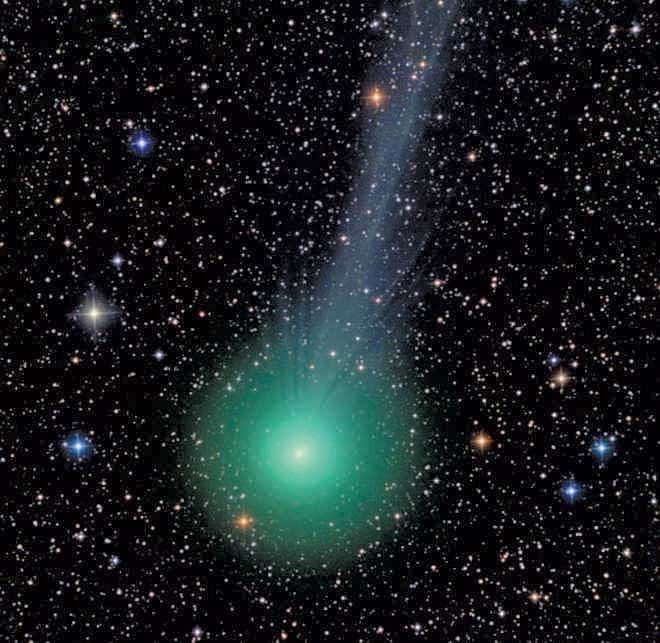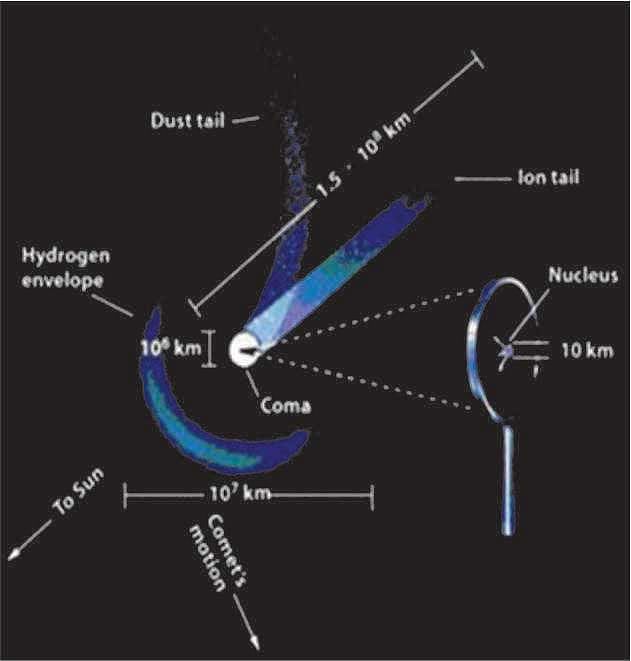A Dazzling New Year's Gift from Heaven COMET LOVEJOY

Nothing in the sky is quite as beautiful as a major comet sweeping through the inner solar system. One such comet, Lovejoy, discovered in 2007 by the amateur Australian astronomer Terry Lovejoy, has heralded the year 2015 in a spectacular fashion. It is the heaven's dazzling New Year's gift to us.
The comet is now closest to the Sun, hence closest to the Earth —approximately 105 million km away. It willshine brightly and adorn the night sky throughout most of January. It can be seen an hour or so after sunset as a fuzzy green glow in the southwestern part of the sky, to the right of the constellation Orion. Although dubbed a naked-eye comet, city dwellers will need a binocular for a better view. From the country side, it can be viewed with the naked eye. The best nights to watch the comet is when the sky is moonless or the moon is waning.
If you miss Lovejoy this time around, you will have to wait 11,500 years for the next sighting!
Comets were formed in the early years of the solar system far from the Sun, where temperatures were very low. In that region, ices combined with methane, ammonia and carbon dioxide to form loose collections of ice and small rocky debris. These “dirty snowballs” in space are called comets.
The Main components of a comet are the nucleus, coma and the long, flowing, diaphanous tails. The nucleus, a few km to 10 km across, contains ice and dust coated with dark organic matter. As the nucleus enters the inner solar system, solar radiation begins to vaporize the ices on its surface, forming a coma of gas and dust. The coma is the head of a comet and has a diameter of about 100,000 km. Surrounding the coma is a huge sphere of hydrogen gas envelope larger than the Sun.
When the comet comes closer to the Sun, the dust particles and other debris in the coma are blown away by solar pressure and solar wind into two long tails— dust tail and the ion tail, extending 10–100 million km from the nucleus. The featureless dust tail is curved and is composed of small, light-reflecting particles. The ion tail, on the other hand, is composed of ionized atoms excited by the ultraviolet radiation from the Sun. It is straight and streaked with wisps and irregularities. Since the tails are shaped by sunlight and solar wind, they always point away from the Sun.

As the comet recedes from the Sun back into the frigid outer solar system, the ices stop vaporizing, and the coma and the tail disappears. The comet goes into an inert state until its next orbit toward the inner solar system.
There are two known reservoirs of comets — Kuiper belt and the Oort cloud. The Kuiper belt, named after the American astronomer Gerard Kuiper, is beyond the orbit of Pluto. The elliptical orbits in this belt range from 35 AU to 200 AU from the Sun. (One AU or astronomical unit is the Earth-Sun distance: 150 million km.)
The vast majority of the several billion comets originate in the Oort cloud, named after the Dutch astronomer Jan Oort. The Oort cloud extends out at least 50,000 AU, almost half way to the nearest star Proxima Centauri. Most Oort cloud comets never come anywhere near the Sun. Indeed, they rarely approach even the orbit of Pluto. If a stray one ever enters the solar system, after one pass by the Sun, the comet will take few thousands to tens of millions of years to return, or may never return if the orbit is hyperbolic.
Comets with periods less than 200 years are called short-period-comet. A period is the time taken to complete one revolution around the Sun. Halley's Comet is a short-period-comet with a period of 76 years. Its next sighting will be in 2061. Comets with periods longer than 200 years are called long-period-comet. Comet Hyakutake, which was seen in March 1996, is such a comet. Its period is 113,707 years.
When a comet approaches a giant planet, the gravitational field of the planet changes the comet's orbit and traps it in the inner solar system, thereby shortening its period. Gravitational perturbation due to other planets can also shorten the period. Jupiter's strong gravitational forces alone shortened the Hale-Bopp Comet's period from 4,206 years to 2,533 years. It was visible to the naked eye from May 1996 to December 1997.
A comet can be destroyed if it comes too close to a planet. In 1992, Comet Shoemaker–Levy disintegrated under the gravitational forces of Jupiter. Two years later, the pieces returned and struck the planet. In many cases, the fragments of a destroyed comet give rise to meteor showers. The dust and debris of the Swift-Tuttle Comet, for example, is responsible for the Perseid meteor shower occurring every year between August 9 and 13.
A comet cannot survive forever. Each time a comet swings past the Sun, it loses mass due to vaporization of ices. After 100 or so swings, all the ices of a typical comet vaporize and the gases blasted away, leaving behind the rocky nucleus. Dead comets may look much like the asteroids, the vagabonds in the sky.
The writer is Professor of Physics at Fordham University, New York.

 For all latest news, follow The Daily Star's Google News channel.
For all latest news, follow The Daily Star's Google News channel. 



Comments